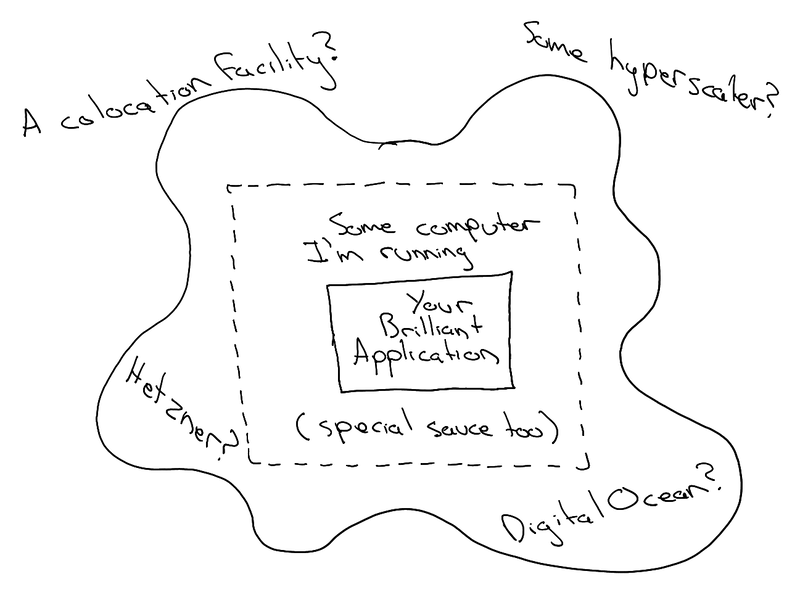I have approximately two main goals with this project:
- Become an internet service provider (ISP) for (at least) one person
- Become a hosting provider (i.e. “a Cloud”) for (at least) one person
For both of these goals, that “one person” is overwhelmingly likely to be yours truly. If any of my neighbors decide to use me as an ISP, or anyone on the internet wants to host things on my platform, that’s just a bonus. Money would definitely be cool though, because this project isn’t particularly cheap.
As for how to actually go about doing any of this, there’s a few different options, with all the tradeoffs you’d expect.
Ways to Become an ISP

I have a vague understanding of how to shuttle packets to and fro the internet.
Becoming an ISP means that people get their internet from you. They send their internet requests through your infrastructure, and you make sure they find their way to the rest of the internet, and vice versa.
By way of demonstration – if one of your customers goes to a “what’s my IP address?” website like https://www.showmyip.com or https://whatismyipaddress.com, the ISP that shows up is you.1
The “Easy” Way
Idea: Just do the last mile infra, get IP addresses and transit from some local provider.
This is the approach recommended by StartYourOwnISP.com, which provides guidance on how to set up a wireless internet service provider (WISP). You buy the (wireless) networking equipment, hook up one end to your customers, and the other end to a pipe to the rest of the internet.
-
Pros
-
You only need the equipment and any old path to the internet
-
Cons
-
You’re pretty beholden to your upstream ISP (e.g. for IP addresses, routing, etc)
-
You have limited control/flexibility in networking things
The Hard Way
Idea: Get your own ASN + IP addresses, work directly with a tier 1 network, do BGP with peers, and literally Become Part of The Internet.
Given that this is the title of the blog post series, it’s pretty clear this is the route we’re going. The next post in the series will likely include a discussion of how the hell to get IPv4 addresses in 2025.
-
Pros
-
More flexibility
-
Nerd cred
-
Autonomy (you own your IPs)
-
You could also lease these from your upstream, which might simplify things
-
Peering is cool, and can potentially reduce costs + improve service quality
-
Reliability, as there’s fewer middlemen
-
Cons
-
Literally everything else
-
It’s significantly more complicated
-
It’s more expensive, as you need capable routing equipment and some sort of relationship with a regional internet registry (RIR)
Ways to Become a Hosting Provider

Insert “The Cloud is Just Someone Else’s Computer” meme here
Becoming a web hosting provider could mean many things. I’m using it to mean people can host their internet-connected applications on my infrastructure. And theoretically pay me money for the privilege.
The Easiest Way
Idea: Build on top of one (or more, if you’re feeling ambitious) major cloud provider(s) and leverage their managed services. Add your special sauce on top.
-
Pros
-
Little to no capex
-
Managed cloud services can do the heavy lifting for things like security, databases, and networking
-
Very quick to set up
-
Cons
-
Massive markup on resources limits your margins
-
Potential for vendor lock-in
-
You’re attempting to compete with your provider
The Medium Option
Idea: Build on top of a VM/hardware hosting provider like DigitalOcean (pricier) or Hetzner (less pricey).
-
Pros
-
Better bang-for-buck on the hardware
-
Much less vendor lock-in (they’re usually just computers)
-
Can bid on server auctions and use dedicated hardware for more savings
-
This is mostly a Hetzner thing
-
Cons
-
Much more manual configuration
-
Little to no redundancy for hardware failures
-
Some hardware (esp on Hetzner) isn’t really “server grade”
The Hard Route
Idea: Buy your own hardware and rack it in a data center/colocation facility. If you want to really go off the deep-end, you can build the data center yourself!
-
Pros
-
You can spec the hardware (CPU, GPU, Network, RAM, etc) to your needs
-
Monthly costs likely scale very sub-linearly with your compute capabilities
-
Better data locality (it’s a box in a place), and maybe data security
-
Cons
-
Literally all the capex
-
Hardware depreciates over time
-
You’re totally on your own for everything
-
You need to vet colocation facilities and pick one
Making Decisions
Perhaps unsurprisingly, I’ve picked approximately the hardest (but also most flexible) options. This is more or less guaranteed to maximize how much I learn and minimize how sane I end up. The only ways to realistically make this more difficult would be to actually build my own data center or to lay my own fiber for every link except the final internet upstream.
Laying dozens of miles of fiber is definitely off the table, but I did legitimately consider building my own data center at one point. The rationale was that land is plentiful near me and it’d be straightforward to power the building with solar and battery. But I’m likely already biting off more than I can chew, no need to guarantee I choke.
I’ve already made some decent strides in getting the various gears in motion, but I’ll save that for future installments in the series.
Though there are some arrangements, like the “Easy” way, where someone else would still show up as the ISP, since you’re using their IPs and likely don’t have your own ASN. ↩